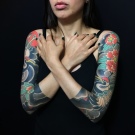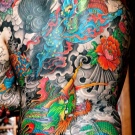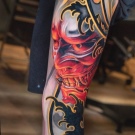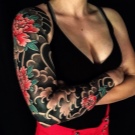Oriental tattoo

Oriental is one of the most ancient tattoo styles with different meanings.... From the material in this article, you will learn what it is, what it is, on which parts of the body it is appropriate.
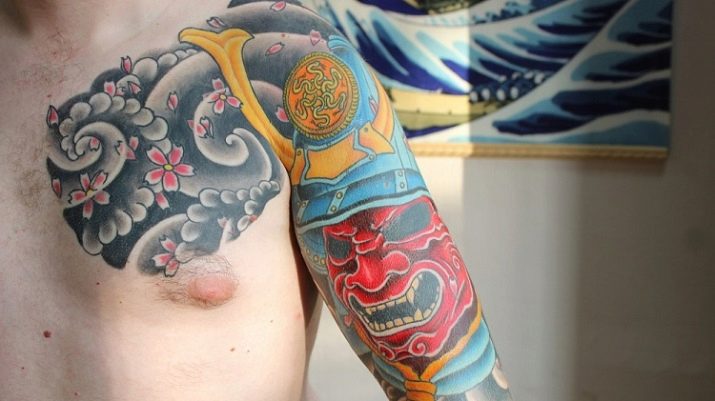

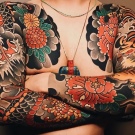
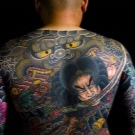
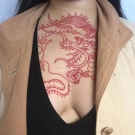
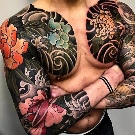
Peculiarities
The oriental style in the art of tattooing has a certain symbolism. Since ancient times, tattoos have been applied as a sign of punishment or as a symbol of nobility of origin. The Japanese school assumes printing a pattern in the form of a body suit. Often these tattoos cover large areas of the body. It happens that the "suit" is knocked out in parts on different zones. Depending on this, the application may take a long time. In our country, the costume technique is not as popular as individual scenes on different parts of the body.
Oriental sketches have a lot of conventions. One of the characteristic features of the style is the manner of stuffing with the effect of movement. The tattoo looks like the picture comes to life. This is achieved through the choice of accents on the relief of the body. Each element of the picture carries a semantic load that changes depending on the gender of the wearer. For example, the symbolism of the peony flower for women indicates beauty, grace, but for men - the belligerence of the owner.

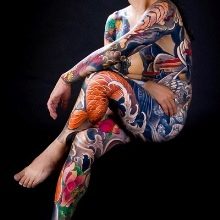
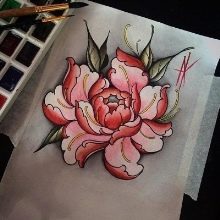
The tiger is considered a sign of autumn and protection from demonic forces. The meaning of dragons depends on the place of printing, additional details, type, color. Many shades are used in the drawings. The main colors are black and red. They are in any oriental tattoo. A characteristic feature of the style is the clarity of the contours. Thanks to this, even small details are visible against the general background of the composition. The figure shows asymmetry. The contours of the tattoo are the thinnest and most smooth lines.
According to Japanese tradition, tattoos are applied to closed parts of the body. The Japanese do not wear revealing clothes.Ideally, the drawing area covers up to 70% of the body. In the classical form, only the hands, head, central part of the abdomen and chest remain clean.
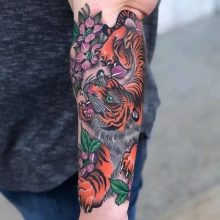
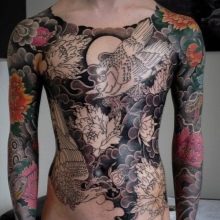
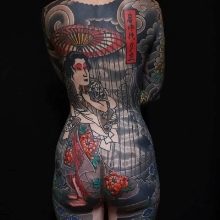
The classic execution of the technique is based on the use of colored ink. With the help of color, the master conveys all the beauty and richness of the motives of the image. Only occasionally are such decorations performed in black and gray tones. The oriental style has a fairly dense color. Because of this, it is used to cover old tattoos. The price of a tattoo is very high, since the work is voluminous and painstaking.
Until recently, images were stuffed with a tebori (a needle attached to a bamboo stick). Modern tattoo artists fill oriental art with electric machines with needles. Due to the large amount of work, the procedure is painful.
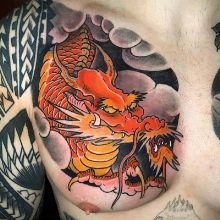
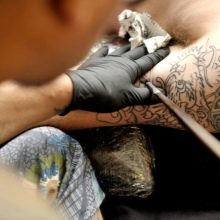
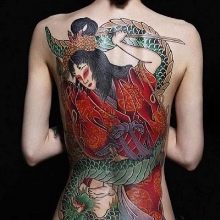
Types and sketches of tattoos
Oriental tattoos are considered universalsuitable for men and women. They are given special importance, therefore, the choice of subjects and details of the drawing has to be approached thoroughly. Most often, when creating a certain composition, the master draws inspiration from oriental legends and philosophical parables. Therefore, not only individual details are important in the drawing, but also their combination and location on the body.
A specific pattern is taken as a basis, which is framed with the smallest elements, inscribing them into a single composition. The drawing includes the nipples and navel. They become part of the drawing (for example, with the eyes of a demon, carp, tiger). Particular attention is paid to the background. Drawing implies dense painting without leaving open areas of the skin. The base of the image can be black, wavy, or floral.
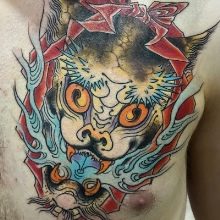

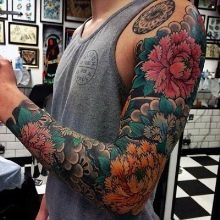
True Japanese style has 3 branches: irezumi, gaman and kakushi-boro. Each direction is a separate art form with its own symbolism and meaning.
- The first is the self-identification of the yakuza (Japanese mafia). Its main character is a Japanese dragon. He personifies unlimited power, wisdom and power. Indicates belonging to a certain group and place in its hierarchy.
- Haman is the style of privileged men. Emphasizes the best qualities of character: patience, self-control, strength. Initially, it was used to decorate the bodies of the best warriors who distinguished themselves in battles and in the service for the good of society.
- Kakushi-boro is a special art form intended exclusively for female geisha. It means rubbing special rice powder into the incisions. The healed pattern practically merges with the skin color. It manifests itself with strong arousal or taking a bath.
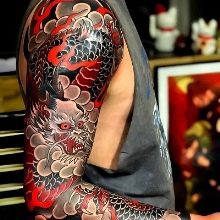
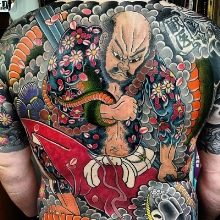
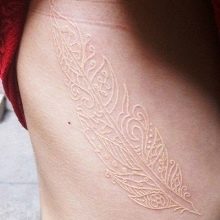
The key elements of the oriental pattern can be very diverse. Popular female subjects are flowers: lotuses, peonies, sakura, chrysanthemums. Often, flower arrangements become a major part of a tattoo. Masks of various types of geisha are no less popular.
Men are more likely to stuff a variety of oriental dragons, koi fish, carp, warriors, and demons. To give it special specifics, the image can be supplemented with hieroglyphs.
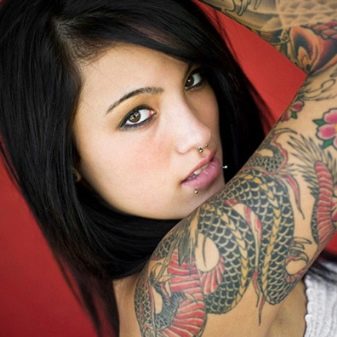
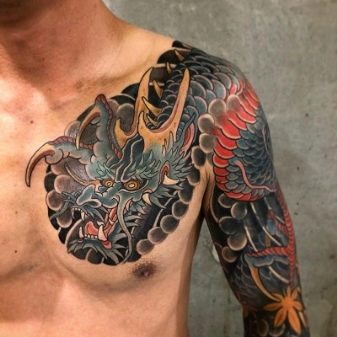
Key elements
The choice of a symbolic figure for the technique is of particular importance.
- For example, the Japanese stuff on the body lampogame - an ancient turtle that foresees the future. This animal is especially revered in eastern countries.
- Pion (the king of flowers among the Japanese) is a symbol of a happy, rich and successful life. Depicted in red, suitable for both sexes.
- Maple Momiji symbolizes the fleetingness of being. It is performed in an orange or red shade, mainly in the form of fallen leaves.
- Lotuses - universal drawing details. On a female body, they mean purity and strength of mind. In masculine, they emphasize the purposefulness of character, are a symbol of immortality.
- Sakuru stuffed with red and pink pigments. She is a symbol of aristocratic origin. On the male body, it means the transience of life.
- Chrysanthemums - emblems of the imperial family.Today they symbolize the calm nature of the owner, mean the calming down of nature. More often used by ladies.
- Usagi (rabbit) separately is not depicted, since it emphasizes not the best character traits of the carrier. However, together with the tiger, it demonstrates the inner harmony of a person.
- Tiger - a key figure in oriental tattoos. Performed canonically in a combination of red, orange and black paints. It testifies to a brave, courageous character, is a talisman of good luck, drives away evil demons.
- Makatsuge - a mythical creature in the form of a fish-like dragon (water dragon). Carried out in black and blue paint. Symbolizes the male sexual principle.
- Sometimes the center of the composition is Bisi (turtle-like dragon). It is generally accepted in Japan that he holds the promise of a successful career. It is a sign of universal harmony, an adornment of male bodies.
- Among other iconic figures, men distinguish and taku (hawk). It is stuffed by the military, individuals with a courageous character, distinguished by inner strength and physical strength.
- No less popular with the Japanese and Baku... The depicted monster is a kind of human amulet. He saves the owner from all kinds of attacks from evil forces.
- Image Kitsune (demonic foxes) are chosen by individuals who count on the favorable attitude of others. The image itself came to Japanese mythology from China, where it meant the ability to reincarnate.
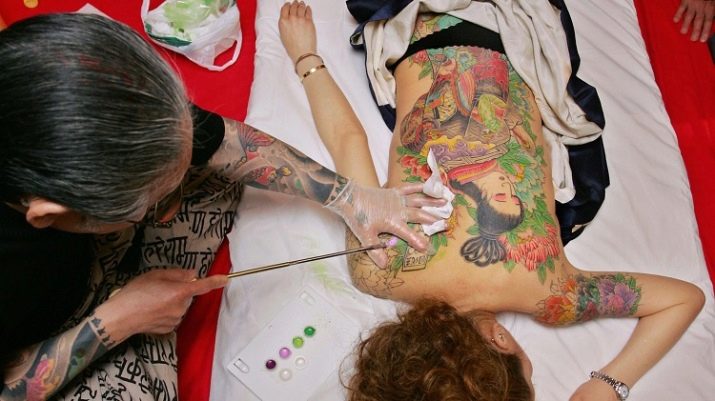
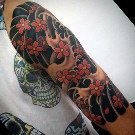
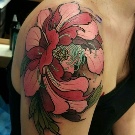
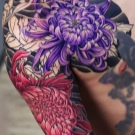

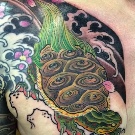
Location options
You can apply an oriental tattoo on a place that is usually covered with clothing. In the classical form, it occupies not only the back of the body, extending to the arms, legs, chest. In our country, tattooing is most often performed on the arm, chest, back. In this case, the drawing can cover several parts of the body at the same time. A classic example is the sleeve technique. An oriental tattoo in the salons of our country often occupies the shoulder, forearm, area above the chest and shoulder blade. Depending on the wishes of the client, it can be symmetrical in volume on both sides of the body, but with a different pattern.
In addition, the craftsmen fill separate designs on the chest and back. At the same time, both men and girls are often asked to get a tattoo in the form of a long T-shirt, reaching to the hips, or even lower. Some style elements can be depicted on the arm below the elbow, on the thigh and even on the neck. The effect of volume and movement is especially conveyed by the relief of the body.
Such tattoos look beautiful on a muscular male sternum or arm. Less often, oriental-style tattoos are stuffed on the leg.

